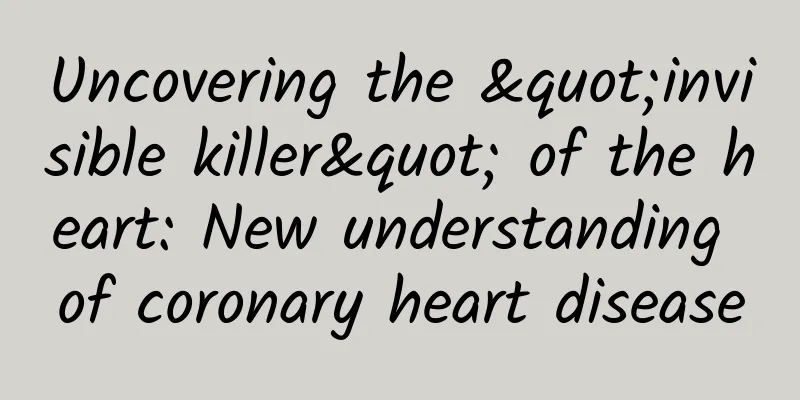Uncovering the "invisible killer" of the heart: New understanding of coronary heart disease

|
Uncovering the "invisible killer" of the heart: New understanding of coronary heart disease Author: Miao Suping, Shanghai Sixth People's Hospital Late at night, the silence of the hospital emergency room was broken by a burst of hurried footsteps. 55-year-old Mr. Zhang, holding his chest and in pain, was supported by his family. He was pale, sweat was oozing from his forehead, and he was gasping for breath. The doctor quickly saw him and, after a series of tests, confirmed that Mr. Zhang had an acute attack of coronary heart disease. What is Coronary Heart Disease Coronary heart disease is a cardiovascular disease caused by coronary atherosclerosis. When plaques are formed on the inner wall of the coronary artery, the blood vessels are narrowed or blocked, and the myocardium cannot get enough blood supply, which leads to ischemia, hypoxia and even necrosis. Its symptoms include angina pectoris and myocardial infarction, which often occur after fatigue, emotional excitement or a full meal. Coronary heart disease is associated with risk factors such as hypertension, hyperlipidemia and diabetes. Prevention requires controlling these risks, maintaining a healthy lifestyle and maintaining heart health. The "hidden killer" of coronary heart disease Coronary heart disease is not something that happens overnight. There are often multiple risk factors behind it. For Mr. Zhang, long-term high blood pressure, high blood lipids and irregular work and rest habits are all the culprits that lead to the onset of coronary heart disease. These "hidden killers" unknowingly erode Mr. Zhang's cardiovascular system, eventually leading to the occurrence of coronary heart disease. However, coronary heart disease is not unpreventable. We can effectively reduce the risk of coronary heart disease by eating a proper diet, exercising moderately, quitting smoking and limiting alcohol consumption, and controlling weight. At the same time, regular physical examinations and timely detection and treatment of diseases such as high blood pressure and high blood lipids are also important means of preventing coronary heart disease. "Warning signs" of coronary heart disease There are often some warning signs before coronary heart disease attacks, such as chest tightness, chest pain, palpitations, etc. Although these signals are short-lived, they cannot be ignored. For Mr. Zhang, it was the appearance of these "warning signals" that made him realize his physical condition in time and take emergency measures. However, in real life, many people turn a blind eye to these warning signs, thinking that they are just minor problems and not worth making a fuss about. Little do they know that such neglect often leads to tragedy. Therefore, we must always pay attention to our physical condition. Once we find any abnormality, we must seek medical treatment in time to avoid missing the best time for treatment. The battle against and recovery from coronary heart disease The treatment of coronary heart disease is a long process that requires joint efforts of patients and doctors. During the acute attack period, doctors will develop personalized treatment plans based on the patient's specific conditions, such as drug therapy, interventional therapy, etc. After the condition stabilizes, patients also need long-term rehabilitation treatment and health management. Rehabilitation treatment includes sports rehabilitation, psychological rehabilitation and dietary rehabilitation. Through scientific exercise plans, psychological adjustment and dietary adjustments, patients can gradually restore their physical functions and improve their quality of life. At the same time, patients also need to go to the hospital for regular review and follow-up to ensure that the disease is controlled and treated in a timely manner. Conclusion: Protecting Heart Health The tense moments in the emergency room for coronary heart disease have made us deeply aware of the importance of heart health. By understanding the causes, prevention, warning signs, treatment and recovery of coronary heart disease, we can better protect our heart health. Let us start from now on, pay attention to heart health, and stay away from the threats of cardiovascular diseases such as coronary heart disease. Let us protect our heart health with a healthy lifestyle, scientific prevention methods and a positive treatment attitude! |
>>: Hot search! Are there fewer lychees this year? Here's how to achieve "lychee freedom" →
Recommend
How to stop bleeding during menopause
After female friends enter menopause, their endoc...
What to do if you have fat on your waist during pregnancy
The fat on the waist during pregnancy can be redu...
Missed one day of long-term contraceptive pills
If you want to take contraceptives for a long tim...
What is the standard shoulder width for girls?
In summer, people wear very few clothes. For wome...
What to do if you have a fever of 38 degrees during confinement
After giving birth, women usually need confinemen...
How to judge whether photovoltaic panels are good or bad? Is photovoltaic power generation a new energy source?
New energy, also known as unconventional energy, ...
Ten days after normal delivery, the lochia suddenly became bright red
All mothers who can give birth to a child know ab...
I keep losing big blood clots during my menstrual period
Blood clots will be discharged during menstruatio...
What should I do if the right fallopian tube is blocked?
The obstruction of the right fallopian tube often...
What are the effects of improper breastfeeding posture on the baby? What are the effects of improper breastfeeding posture on the mother?
What will happen if the breastfeeding posture is ...
Eat three kinds of fruits at night to lose weight, why don’t you try it?
It is useless to rely on exercise alone to lose w...
Bleeding and stomach pain during pregnancy
Pregnancy is a happy thing, but there are also ma...
Do women also need calcium supplements?
Many people know that children need calcium suppl...
What causes blood clots in early menstruation?
Every time a woman has her period, she must pay m...
Do students need to wear masks in class after school starts? What should students do if they don’t have masks after school starts?
The school will not stop students from going to s...









